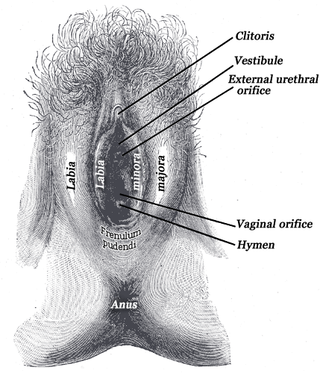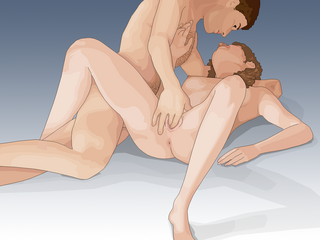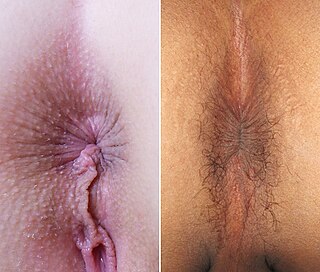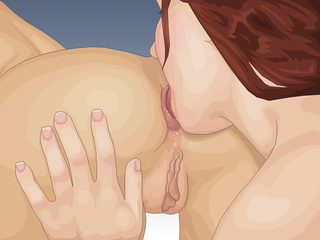Anal sex or anal intercourse is generally the insertion and thrusting of the erect penis into a person's anus, or anus and rectum, for sexual pleasure. Other forms of anal sex include anal fingering, the use of sex toys, anilingus, pegging, as well as electrostimulation and erotic torture such as figging. Although anal sex most commonly means penile–anal penetration, sources sometimes use anal intercourse to exclusively denote penile–anal penetration, and anal sex to denote any form of anal sexual activity, especially between pairings as opposed to anal masturbation.

The anus is an opening at the opposite end of an animal's digestive tract from the mouth. Its function is to control the expulsion of feces, the residual semi-solid waste that remains after food digestion, which, depending on the type of animal, includes: matter which the animal cannot digest, such as bones; food material after the nutrients have been extracted, for example cellulose or lignin; ingested matter which would be toxic if it remained in the digestive tract; and dead or excess gut bacteria and other endosymbionts.

Safe sex is sexual activity using methods or contraceptive devices to reduce the risk of transmitting or acquiring sexually transmitted infections (STIs), especially HIV. "Safe sex" is also sometimes referred to as safer sex or protected sex to indicate that some safe sex practices do not eliminate STI risks. It is also sometimes used colloquially to describe methods aimed at preventing pregnancy that may or may not also lower STI risks.

The perineum in humans is the space between the anus and scrotum in the male, or between the anus and the vulva in the female. The perineum is the region of the body between the pubic symphysis and the coccyx, including the perineal body and surrounding structures. There is some variability in how the boundaries are defined. The perineal raphe is visible and pronounced to varying degrees. The perineum is an erogenous zone. This area is known as the taint or chode in American slang.

A butt plug is a sex toy that is designed to be inserted into the rectum for sexual pleasure. They are similar to a dildo in some ways but tend to be shorter and have a flanged end to prevent the device from being lost inside the rectum.

Anal beads are a sex toy consisting of multiple balls attached in series. Individual balls are continuously inserted through the anus into the rectum and then removed with varying speeds depending on the desired effect. The main use of anal beads are for sexual stimulation.

The frenulum of labia minora is a frenulum where the labia minora meet posteriorly.

Sexual penetration is the insertion of a body part or other object into a body orifice, such as the mouth, vagina or anus, as part of human sexual activity or sexual behavior in non-human animals.

Personal lubricants are specialized lubricants used during sexual acts, such as intercourse and masturbation, to reduce friction to or between the penis and vagina, anus or other body parts or applied to sex toys to reduce friction or to ease penetration. Surgical or medical lubricants or gels, which are similar to personal lubricants but not usually referred to or labelled as "personal" lubricants, may be used for medical purposes such as speculum insertion or introduction of a catheter. The primary difference between personal and surgical lubricants is that surgical lubricants are thicker, sterile gels, typically containing a bacteriostatic agent. As of 2015 the personal lubricant market was estimated to be worth at least $400 million.

Genital piercing is a form of body piercing that involves piercing a part of the genitalia, thus creating a suitable place for wearing different types of jewellery. Nevertheless, the term may also be used pars pro toto to indicate all body piercings in the area of anus, perineum, genitals and mons pubis, including piercings such as anal, guiche, and pubic that do not involve perforation of genitalia. Genital piercings can be done regardless of sex, with various forms of piercings available. The main motive is beautification and individualization; in addition, some piercings enhance sexual pleasure by increasing stimulation. Pre-modern genital piercings is most culturally widespread in Southeast Asia, where it has been part of traditional practice since ancient times. Records of genital piercing are found in the Kama Sutra.

Genital tattooing is the practice of placing permanent marks under the skin of the genitals in the form of tattoos.

A triangle piercing is one of several forms of genital piercing applied to the vulva. It is a horizontal piercing that passes from side to side, beneath the base of the clitoral hood tissue where it meets the inner labia and under the clitoris. The name is derived from the tissue where the labia meets the clitoral hood, which looks like a triangle when pinched.

Anal masturbation is an autoerotic practice in which a person masturbates by sexually stimulating their own anus and rectum. Common methods of anal masturbation include manual stimulation of the anal opening and the insertion of an object or objects. Items inserted may be sex toys such as anal beads, butt plugs, dildos, vibrators, or specially designed prostate massagers, or enemas.
Anal bleaching is the process of lightening the color of the skin around the anus. It is done for cosmetic purposes, to make the color of the anus more uniform with the surrounding area. Some treatments are applied in an office or salon by a cosmetic technician and others are sold as cream that can be applied at home.

Fingering is sexual stimulation of the vulva or vagina by using the fingers. Vaginal fingering is legally and medically called digital penetration or digital penetration of the vagina. The term "digital" takes its significance from the English word 'digit,' which refers to a finger, thumb, or toe. Fingering may also include the use of fingers to stimulate the anus.
Goodsall's rule relates the external opening of an anal fistula to its internal opening. It states that if the perianal skin opening is posterior to the transverse anal line, the fistulous tract will open into the anal canal in the midline posteriorly, sometimes taking a curvilinear course. A perianal skin opening anterior to the transverse anal line is usually associated with a radial fistulous tract.

Non-penetrative sex or outercourse is sexual activity that usually does not include sexual penetration. It generally excludes the penetrative aspects of vaginal, anal, or oral sex, but includes various forms of sexual and non-sexual activity, such as frottage, manual sex, mutual masturbation, kissing, or cuddling. Some forms of non-penetrative sex, particularly when termed outercourse, include penetrative aspects, such as penetration that may result from forms of fingering or oral sex.

In humans, the anus is the external opening of the rectum, located inside the intergluteal cleft and separated from the genitals by the perineum. Two sphincters control the exit of feces from the body during an act of defecation, which is the primary function of the anus. These are the internal anal sphincter and the external anal sphincter, which are circular muscles that normally maintain constriction of the orifice and which relaxes as required by normal physiological functioning. The inner sphincter is involuntary and the outer is voluntary. It is located behind the perineum which is located behind the vulva or scrotum.

Anilingus is an oral and anal sex act in which a person stimulates the anus of another by using the tongue and lips. It is also called anal–oral contact and anal–oral sex.

Sexualization of the buttocks, especially of the female sex, has occurred throughout history.

















